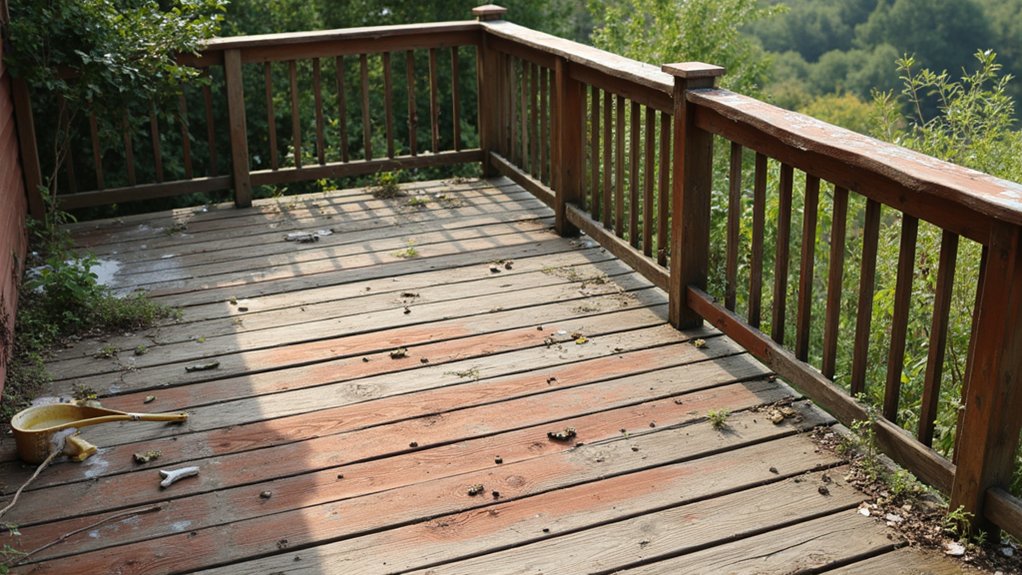When you decide to paint your deck, it is crucial to get it right. A poorly executed project can lead to a finish that’s more eyesore than eye-catching. You’ve invested time and money into your outdoor space, so don’t let common mistakes sabotage your efforts. From neglecting surface prep to applying the wrong number of coats, there are several missteps that can derail your deck painting project. Let’s take a closer look at the top 5 mistakes homeowners make, so you can avoid them and achieve a beautiful, long-lasting finish.
Failing to Prepare the Deck Surface
Because a deck’s surface is constantly exposed to the elements, failing to prepare it properly before painting is a rookie mistake that can lead to a subpar finish. You’ll be surprised how often homeowners overlook the deck’s condition, neglecting surface cleaning, and assuming a fresh coat of paint will magically fix everything. Don’t fall into this trap!
Take the time to inspect your deck for signs of wear, such as cracks, rot, or warping. Then, give it a thorough cleaning to remove dirt, grime, and mildew. Use a pressure washer if necessary, but be careful not to damage the wood. Finally, sand the surface to create a smooth, even finish. By doing so, you’ll guarantee a strong bond between the wood and the paint, resulting in a beautiful, long-lasting finish that will make you proud to show off your outdoor space. Remember, proper preparation also helps in preventing moisture damage and extends the life of your deck.
Choosing the Wrong Paint or Stain
You’ve prepped your deck surface, now it’s time to select the appropriate paint or stain. This is a vital step, as the wrong choice can lead to a finish that’s less than desirable.
When selecting a paint or stain, don’t overlook the age of your deck. If your deck is older, it may require a specific type of coating to guarantee it holds up well. Additionally, consider the traffic your deck gets. If it’s a high-traffic area, you’ll want a paint or stain that’s durable and resistant to wear and tear.
Avoid selecting an improper paint finish, such as a glossy finish on a deck that gets a lot of foot traffic. This can lead to a slippery surface, creating a safety hazard. By choosing the right paint or stain, you’ll secure a beautiful, long-lasting finish that complements your outdoor living space. Also, prioritize using non-toxic paint to ensure the safety of your family and pets during and after the painting process.
Not Considering the Deck’s Exposure to the Elements
As your deck is exposed to the elements, it’s crucial to ponder how weather conditions will influence your paint or stain job. Neglecting weather-resistant finishes can lead to a premature deterioration of your deck’s surface. You must consider the amount of sunlight, rain, and snow your deck is exposed to, and choose a finish that can endure these conditions.
Overlooking deck cleaning requirements is another common mistake. Failing to clean your deck before applying paint or stain can result in a weak bond between the finish and the deck’s surface, leading to peeling and flaking. Make sure to clean your deck thoroughly before applying any finishes, and choose a finish that’s suitable for your deck’s level of exposure.
Ignoring the Importance of Primer
Cleanliness is just the beginning; a well-prepared deck surface is also dependent on a suitable primer. Skipping prepping wood and neglecting primer application can lead to a failed paint job. Primer helps create a strong bond between the wood and the paint, ensuring a durable and long-lasting finish.
When you skip primer, you risk:
- Weak adhesion, causing paint to peel or flake off
- Uneven color distribution, resulting in an unattractive finish
- Wood grain showing through the paint, compromising the overall look
- Increased maintenance, as the paint job won’t last as long as it should
Applying Too Many Coats or Insufficient Coats
The number of coats you apply can tremendously impact the final result of your deck painting project. Applying too many coats can lead to an uneven application, as each layer may not dry properly before the next one is applied. This can cause the paint to pool, creating an uneven finish.
On the other hand, applying too few coats may not provide adequate coverage, leaving your deck vulnerable to the elements. Improper drying times can also occur when you apply multiple thin coats too quickly, rather than allowing each coat to dry according to the manufacturer’s instructions.
To avoid these mistakes, always read and follow the instructions on the paint can, and apply coats in thin, even layers, allowing each layer to dry completely before applying the next. This will guarantee a smooth, even finish that will safeguard your deck for years to come.
Frequently Asked Questions
Can I Use a Roller to Paint My Entire Deck?
When painting your deck, you can use a roller for large areas, but choose the right one: using different paint rollers with the correct roller nap guarantees a smooth finish and prevents texture buildup.
How Long Does It Take for Deck Paint to Fully Dry?
You’ll want to wait for the recommended 24 to 48 hours for deck paint to fully dry, but this timeframe can vary depending on ideal drying conditions, such as temperature, humidity, and air circulation, so be patient and follow the manufacturer’s instructions.
Can I Paint My Deck in Direct Sunlight?
When painting your deck, you shouldn’t do it in direct sunlight, as it can cause the paint to dry too quickly, leading to uneven finishes. Instead, prepare the surface thoroughly and avoid painting wet wood for a smooth, long-lasting result.
Do I Need to Remove Old Stain Before Repainting?
When repainting your deck, you’ll need to remove old stain to confirm proper surface preparation. Check the manufacturer’s recommendations for the best approach, as some products may require stripping or sanding to certify a strong bond between old and new coatings.
Can I Use Regular House Paint on My Deck?
You can’t use regular house paint on your deck, as it’s not designed for horizontal surfaces or outdoor exposure. Instead, choose a paint specifically labeled for decks or fences, which guarantees compatibility and meets surface preparation requirements for a durable finish.

